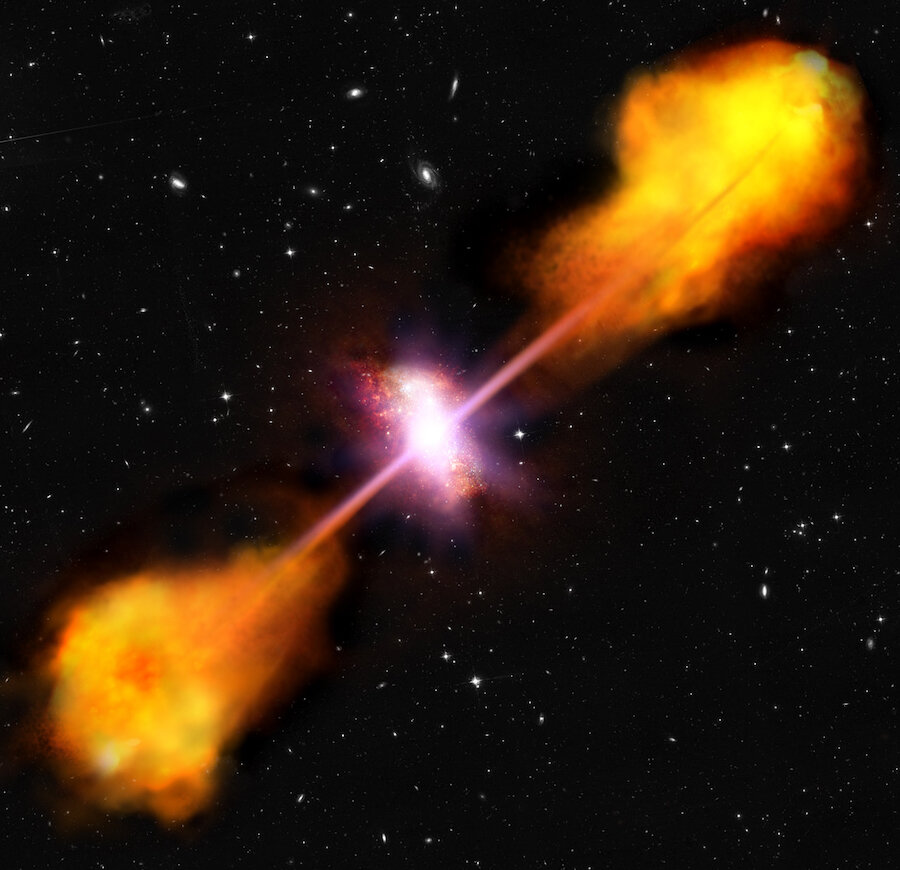
Artist’s impression of a galaxy with an active core, a supermassive black hole in the middle. If the black hole is important, two powerful rays can form on the sides of the black hole. These radiators form huge ‘radio clouds’ that can be detected by radio telescopes. Credit: ESA / C. Carreau
All supermassive black holes in the centers of galaxies appear to have periods when they swallow matter in their immediate vicinity. But that’s about as far as the agreements go. This is the conclusion that British and Dutch astronomers have reached from their research using ultra-sensitive radio telescopes in a well-studied region of the universe. They publish their findings in two articles in the international journal Astronomy & Astrophysics.
Astronomers have been studying active galaxies since the 1950s. Active galaxies have a super-massive black hole in their middle that swallows matter. During these active phases, the objects often emit extremely strong radio, infrared, ultraviolet and X-ray radiation.
In two new publications, an international team of astronomers has focused on all the active galaxies in the well-studied GOODS North region in the constellation Ursa Major. Until now, the region has been studied mainly by space telescopes that collect visible light, infrared light and UV light. The new observations add data from sensitive networks of radio telescopes, including the UK e-MERLIN national facility and the European VLBI (EVN) network.
Thanks to this systematic study, three things became clear. First, it appears that the nuclei of different types of galaxies can be active in different ways. Some are extremely greedy and devour as much material as they can; others digest their food more slowly, and others are almost hungry.
Second, an accretion phase sometimes occurs with a star formation phase and sometimes not. When star formation is underway, it is difficult to detect activity in the nucleus.
Third, the nuclear washing process may or may not generate radio emitters – regardless of the speed at which the black hole swallows the food.
According to principal investigator Jack Radcliffe (formerly University of Groningen and ASTRON in the Netherlands and University of Manchester in the United Kingdom, now University of Pretoria, South Africa), the observations also show that radio telescopes are optimally useful for the eating habits of black holes in the distance. universe. “This is good news because the SKA radio telescopes are coming, and it will enable us to look deeper into the universe with even more details.”
Co-author Peter Barthel (University of Groningen, The Netherlands) adds: “We are getting more and more indications that all galaxies have huge massive black holes in their centers. This must of course have grown to their current mass. It seems that, thanks to us observations, we now have these growth processes in mind and we are slowly but surely beginning to understand them. ‘
Co-author Michael Garrett (University of Manchester, UK) adds: “These stunning results demonstrate the unique capabilities of radio astronomy. Telescopes such as the VLA, e-MERLIN and the EVN are transforming our view of how galaxies evolve in the early stages of the universe. . ”
Discover the most remote quasar with powerful radio emitters
Nowhere to hide: Radio-faint AGN in the GOODS-N field. By: JF Radcliffe et al. Accept for publication in Astronomy & Astrophysics.
Original: doi.org/10.1051/0004-6361/202038591
Free preview: arxiv.org/abs/2103.08575v2 arXiv: 2103.08575v2 [astro-ph.GA]
The radio emission of Active Galactic Nuclei. By: JF Radcliffe et al. Accept for publication in Astronomy & Astrophysics.
Original: www.aanda.org
Free pre-print: arxiv.org/abs/2104.04519 arXiv: 2104.04519v1 [astro-ph.GA]
Provided by the Dutch Research School of Astronomy
Quotation: Black holes love to eat but have a variety of table manners (2021, April 13), detected on April 13, 2021 from https://phys.org/news/2021-04-black-holes-variety-table-manners. html
This document is subject to copyright. Except for any fair trade for the purpose of private study or research, no portion may be reproduced without the written permission. The content is provided for informational purposes only.
